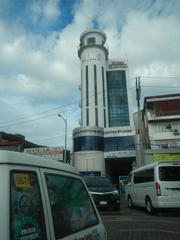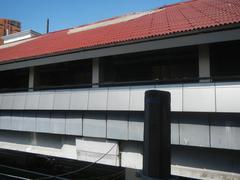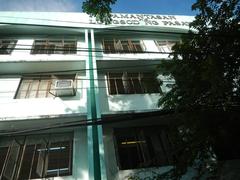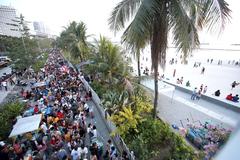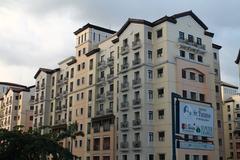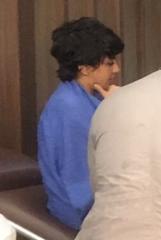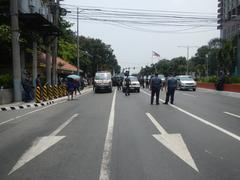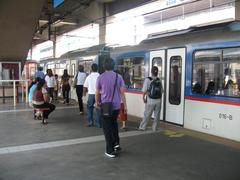Cultural Center of the Philippines Complex Pasay: Visiting Hours, Tickets, and Historical Sites Guide
Date: 14/06/2025
Introduction
The Cultural Center of the Philippines (CCP) Complex in Pasay City is a cornerstone of Filipino arts, culture, and national identity. Established in 1966 and realized through the vision of Imelda Marcos and the architectural mastery of National Artist Leandro V. Locsin, the CCP Complex is a testament to the country’s dedication to nurturing creativity and heritage. Here, visitors can expect a dynamic blend of iconic architecture, world-class performances, vibrant festivals, and immersive exhibitions—all set against the scenic backdrop of Manila Bay (CCP official site; When In Manila).
This comprehensive guide covers everything you need to know about visiting the CCP Complex: from historical context and architectural highlights to up-to-date visitor information, ticketing, accessibility, travel tips, and notable events. Whether you’re an art lover, a history buff, or a first-time tourist, this guide will help you experience the very best of Filipino culture in Pasay.
Table of Contents
- Historical Background and Cultural Significance
- Visitor Information
- Signature Events and Festivals
- Architectural Vision and Key Structures
- Artistic Programming and Highlights
- Urban Planning and Landscape
- Visitor Experience and Amenities
- Preservation and Future Developments
- Frequently Asked Questions (FAQ)
- Visuals and Interactive Elements
- Legacy and Continuing Influence
- Conclusion and Call to Action
- References
Historical Background and Cultural Significance
Origins and Vision
The CCP Complex was established in 1966 through Executive Order No. 30, spearheaded by then First Lady Imelda Marcos. Her ambition was to create a premier institution for Filipino artistic expression, furthering both national pride and cultural exchange. The project secured funding through both international diplomacy and private donations, including a significant grant from the U.S. government (When In Manila).
Construction of the Tanghalang Pambansa (National Theater) began in 1966 and concluded in 1969. Designed by Leandro V. Locsin, the building’s inauguration was a grand affair, symbolizing the birth of a modern Filipino arts movement (When In Manila).
Architectural Significance and Urban Context
Occupying 62 hectares of reclaimed land along Roxas Boulevard, the CCP Complex is a prime example of Brutalist architecture. Locsin’s designs feature bold concrete forms and innovative use of open space, distinguished from Manila’s earlier colonial and neoclassical buildings (Kurby Blog). The integration of indoor and outdoor environments, wide lawns, and Manila Bay views create a unique setting for cultural engagement (Slideshare).
Evolution Through Decades
Since its opening, the CCP has reflected the nation’s political and cultural shifts. Its programming and leadership have adapted to changing times—from the Martial Law era to the post-EDSA period, when the institution expanded its reach and democratized access to the arts (Manila Standard). Initiatives such as “Arts for the People” and landmark legal victories in land ownership have further established the CCP as a guardian of national culture.
Cultural Impact and National Identity
The CCP Complex embodies the Filipino values of truth, beauty, and goodness, as well as excellence, respect, and integrity (CCP official site). It serves as the home for notable resident companies—including the Philippine Philharmonic Orchestra, Ballet Philippines, and Tanghalang Pilipino—and as the birthplace of influential festivals such as Cinemalaya and Pasinaya (Tatler Asia).
Visitor Information
Visiting Hours
- General hours: Tuesday–Sunday, 10:00 AM–6:00 PM
- Closed on Mondays and select holidays
- Some venues may have extended hours for specific events
- Check the official CCP website for the most current details
Ticket Prices and Purchasing
- Prices range from PHP 150 to PHP 1,500 depending on event/venue
- Discounted rates for students, senior citizens, and PWDs
- Purchase options:
- Online via CCP
- CCP box office
- Authorized ticket outlets
- Many festivals, such as Pasinaya, feature free or “pay-what-you-can” entry
Accessibility
- Ramps, elevators, and designated seating for persons with disabilities
- Accessible restrooms and parking spaces
- Assistance available upon request—advance notice recommended
Guided Tours
- Guided tours may be booked in advance through CCP visitor services
- Tours offer insights into the CCP’s history, architecture, and resident companies
Travel Tips and Parking
- Accessible via Roxas Boulevard by jeepney, bus, or LRT (nearest EDSA-Taft station)
- Ample parking available, though it fills quickly during major events
- Arrive early to avoid traffic and secure good parking
Nearby Attractions
- Rizal Park (Luneta)
- National Museum Complex
- Mall of Asia
- Manila Baywalk (famous for sunset views)
Signature Events and Festivals
Pasinaya Open House Festival
The annual Pasinaya Festival, themed “Para sa Lahat” (“For Everyone”), is the country’s largest multi-arts event, featuring dance, theater, music, workshops, and exhibitions. Its “pay-what-you-can, see-all-you-can” model ensures inclusivity and accessibility (Tatler Asia). In 2025, Pasinaya expanded to regional and international partner sites and continues to attract thousands of artists and visitors.
Other Major Events
- Virgin Labfest: Annual festival of new Filipino plays (CCP Events)
- Facade Lighting Events: Themed illuminations for Pride Month and Independence Day
- TANOD-LUPA Exhibit: Public art blending folklore and contemporary themes
- 21AM Collection Exhibitions: Contemporary Filipino art on display at CCP and the National Museum
Architectural Vision and Key Structures
Tanghalang Pambansa (National Theater)
Designed by Locsin and opened in 1969, the Tanghalang Pambansa is the CCP’s flagship venue. Its dramatic façade, floating volume, and use of indigenous materials define its modern Filipino identity (Architectuul; Fabulous Philippines). The main theater (Tanghalang Nicanor Abelardo) is renowned for acoustics and elegance.
Other Key Structures
- Philippine International Convention Center (PICC): Major venue for international events (Kanto)
- Folk Arts Theater: Column-free space for large performances (Wikipedia)
- Coconut Palace: Celebrates Filipino craftsmanship with local materials
- Manila Film Center: Iconic for its Brutalist design
Artistic Programming and Highlights
Exhibitions
CCP galleries include the Museo ng Sining and Museo ng Kalinangang Pilipino, offering rotating and permanent exhibitions of visual arts (Fabulous Philippines). The Visual Arts and Museum Division curates contemporary and traditional Filipino art, with international collaborations on display (CCP Media Release).
Resident Companies and Performances
Nine resident companies call the CCP home, among them:
- Philippine Philharmonic Orchestra
- Ballet Philippines
- Tanghalang Pilipino
- Philippine Madrigal Singers
Venues include the Main Theater, Little Theater, Studio Theater, and Folk Arts Theater (EPA CCP).
Festivals & International Collaborations
- Cinemalaya Film Festival: Showcasing independent Filipino cinema
- The Met: Live in HD: Opera broadcasts from New York
- ToyCon and Cosplay Events: Pop culture highlights
Urban Planning and Landscape
The CCP Complex is master-planned into art and commercial zones, set within landscaped gardens and open plazas. Orientation of buildings maximizes Manila Bay views, and the site is designed for both grand events and casual recreation (Wikipedia).
Visitor Experience and Amenities
- Guided Tours: Booked in advance; ideal for first-timers
- Dining: Cafes and restaurants within and near the complex
- Retail: Souvenir shops with local art and crafts
- Parking: Available, but limited during major events
- Accessibility: Comprehensive facilities for all visitors
Travel Tips:
- Check event schedules before visiting
- Arrive early for best parking and seating
- Smart casual attire is suggested; formal for gala events
- Photography is permitted in public spaces but not during performances
Preservation and Future Developments
Ongoing renovations, including a major restoration of the Main Building, aim for a grand reopening in 2026. The CCP’s 10-year redevelopment plan includes new venues, green spaces, and enhanced amenities, ensuring its continued relevance (Manila Standard; Wikipedia; Kanto).
Frequently Asked Questions (FAQ)
Q: What are the CCP visiting hours?
A: Generally 10:00 AM–6:00 PM (Tuesday–Sunday), but check the official website for updates.
Q: How can I buy tickets?
A: Purchase online, at the box office, or via authorized outlets.
Q: Is the CCP accessible for people with disabilities?
A: Yes, with ramps, elevators, accessible restrooms, and special seating.
Q: Are there guided tours?
A: Yes, tours can be booked in advance.
Q: Where is the CCP located and how do I get there?
A: Along Roxas Boulevard, Pasay City, near the EDSA-Taft MRT station. Accessible by public and private transport.
Q: Can I take photos at the CCP?
A: Yes, in public areas and during façade lighting; not during performances.
Visuals and Interactive Elements
Explore the CCP’s virtual tours and interactive map for a preview of the complex and its venues. High-resolution images of the CCP façade, event highlights, and Manila Bay views enrich the visitor experience.
Legacy and Continuing Influence
For over fifty years, the CCP Complex has stood at the intersection of Filipino heritage and contemporary creativity. Its architectural splendor and diverse programming make it a beacon for generations of artists, audiences, and cultural advocates (CCP official site; Tatler Asia). As it embarks on its next chapter, the CCP remains a vital institution for national identity and artistic excellence.
Conclusion and Call to Action
Embrace the opportunity to discover the Cultural Center of the Philippines Complex—a living landmark where tradition meets innovation. Check the official CCP website for updated schedules, ticketing, and guided tours. Enhance your cultural journey by visiting nearby attractions and following CCP’s social media channels. Download the Audiala app for curated guides and exclusive content.
Celebrate Filipino artistry, experience world-class performances, and witness the enduring legacy of the CCP Complex on your next visit to Pasay City.
References
- Cultural Center of the Philippines official site, 2025 (https://culturalcenter.gov.ph/about/)
- When In Manila, 2025, The Cultural Center of the Philippines: Home of Filipino Culture and Arts (https://www.wheninmanila.com/the-cultural-center-of-the-philippines-home-of-filipino-culture-and-arts/)
- Tatler Asia, 2025, CCP Pasinaya Festival 2025 Expands and Embraces All (https://www.tatlerasia.com/lifestyle/arts/ccp-pasinaya-2025)
- Kurby Blog, 2025, From Past to Present: The Evolution of Pasay City and Filipino Architecture (https://blog.kurby.ai/from-past-to-present-the-evolution-of-pasay-city-philippiness-architecture/)
- Manila Standard, 2025, CCP Historical and Cultural Evolution (https://manilastandard.net/?p=314498486)
- EPA CCP, 2025, About CCP (https://epa.culturalcenter.gov.ph/ccp-about/)
- Wikipedia, 2025, Cultural Center of the Philippines Complex (https://en.wikipedia.org/wiki/Cultural_Center_of_the_Philippines_Complex)
- Kanto, 2025, Revisiting Life and Works of Leandro Locsin (https://kanto.ph/spaces/architecture/revisiting-life-and-works-leandro-locsin/)
- Fabulous Philippines, 2025, Cultural Center of the Philippines (https://www.fabulousphilippines.com/cultural-center-manila.html)
